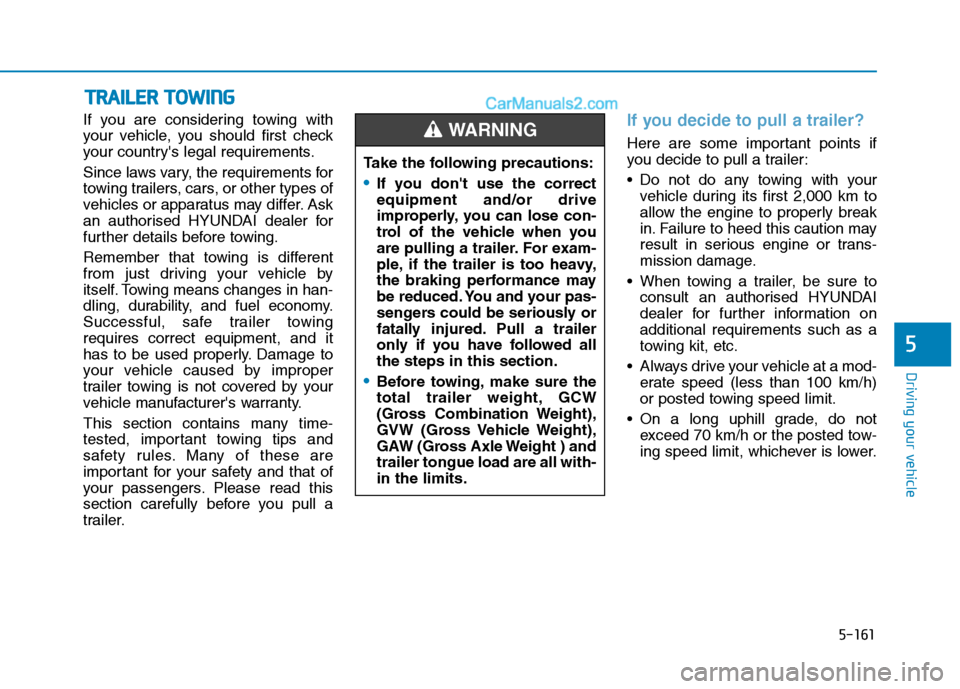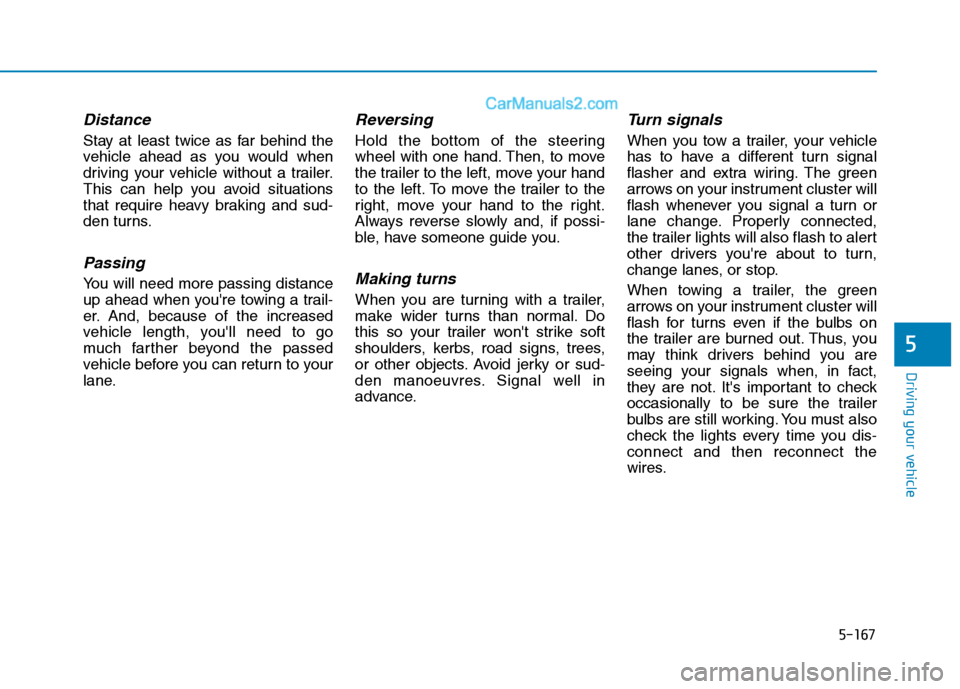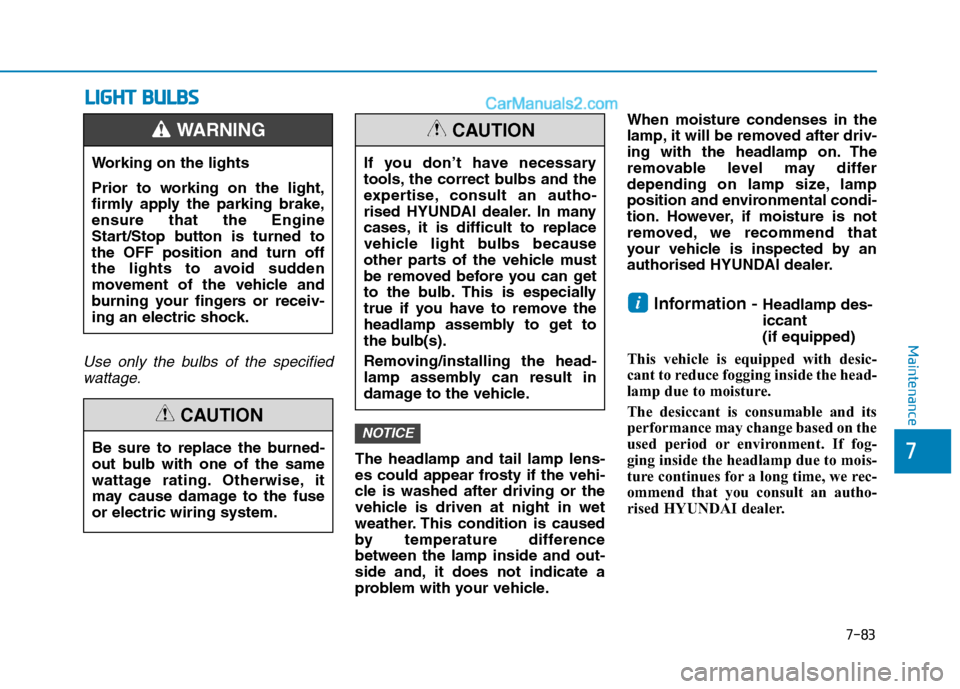Page 459 of 637
5-142
For example, if you drive at 90 km/h,
the is distance maintain as follows:
Distance 4 - approximately 52.5 m
Distance 3 - approximately 40 m
Distance 2 - approximately 32.5 m
Distance 1 - approximately 25 m
Information
The distance is set to the last set dis-
tance when the system is used for the
first time after starting the engine.
When the lane ahead is clear:
The vehicle speed will maintain the
set speed.
When there is a vehicle ahead
of you in your lane:
Your vehicle speed will slow down
or speed up to maintain the select-
ed distance.
If the vehicle ahead speeds up,
your vehicle will travel at a steady
cruising speed after accelerating to
the set speed.
If distance from the front vehicle
has been changed due to acceler-
ating or decelerating of the front
vehicle, the distance on the LCD
may be changed.
i
Driving your vehicle
OTLE058212
Distance 4Distance 3
Distance 1Distance 2OTLE058213/OTLE058214/OTLE058215/OTLE058216
Page 478 of 637

5-161
Driving your vehicle
5
If you are considering towing with
your vehicle, you should first check
your country's legal requirements.
Since laws vary, the requirements for
towing trailers, cars, or other types of
vehicles or apparatus may differ. Ask
an authorised HYUNDAI dealer for
further details before towing.
Remember that towing is different
from just driving your vehicle by
itself. Towing means changes in han-
dling, durability, and fuel economy.
Successful, safe trailer towing
requires correct equipment, and it
has to be used properly. Damage to
your vehicle caused by improper
trailer towing is not covered by your
vehicle manufacturer's warranty.
This section contains many time-
tested, important towing tips and
safety rules. Many of these are
important for your safety and that of
your passengers. Please read this
section carefully before you pull a
trailer.If you decide to pull a trailer?
Here are some important points if
you decide to pull a trailer:
Do not do any towing with your
vehicle during its first 2,000 km to
allow the engine to properly break
in. Failure to heed this caution may
result in serious engine or trans-
mission damage.
When towing a trailer, be sure to
consult an authorised HYUNDAI
dealer for further information on
additional requirements such as a
towing kit, etc.
Always drive your vehicle at a mod-
erate speed (less than 100 km/h)
or posted towing speed limit.
On a long uphill grade, do not
exceed 70 km/h or the posted tow-
ing speed limit, whichever is lower.
T TR
RA
AI
IL
LE
ER
R
T
TO
OW
WI
IN
NG
G
Take the following precautions:
If you don't use the correct
equipment and/or drive
improperly, you can lose con-
trol of the vehicle when you
are pulling a trailer. For exam-
ple, if the trailer is too heavy,
the braking performance may
be reduced. You and your pas-
sengers could be seriously or
fatally injured. Pull a trailer
only if you have followed all
the steps in this section.
Before towing, make sure the
total trailer weight, GCW
(Gross Combination Weight),
GVW (Gross Vehicle Weight),
GAW (Gross Axle Weight ) and
trailer tongue load are all with-
in the limits.
WARNING
Page 484 of 637

5-167
Driving your vehicle
5
Distance
Stay at least twice as far behind the
vehicle ahead as you would when
driving your vehicle without a trailer.
This can help you avoid situations
that require heavy braking and sud-
den turns.
Passing
You will need more passing distance
up ahead when you're towing a trail-
er. And, because of the increased
vehicle length, you'll need to go
much farther beyond the passed
vehicle before you can return to your
lane.
Reversing
Hold the bottom of the steering
wheel with one hand. Then, to move
the trailer to the left, move your hand
to the left. To move the trailer to the
right, move your hand to the right.
Always reverse slowly and, if possi-
ble, have someone guide you.
Making turns
When you are turning with a trailer,
make wider turns than normal. Do
this so your trailer won't strike soft
shoulders, kerbs, road signs, trees,
or other objects. Avoid jerky or sud-
den manoeuvres. Signal well in
advance.
Turn signals
When you tow a trailer, your vehicle
has to have a different turn signal
flasher and extra wiring. The green
arrows on your instrument cluster will
flash whenever you signal a turn or
lane change. Properly connected,
the trailer lights will also flash to alert
other drivers you're about to turn,
change lanes, or stop.
When towing a trailer, the green
arrows on your instrument cluster will
flash for turns even if the bulbs on
the trailer are burned out. Thus, you
may think drivers behind you are
seeing your signals when, in fact,
they are not. It's important to check
occasionally to be sure the trailer
bulbs are still working. You must also
check the lights every time you dis-
connect and then reconnect the
wires.
Page 529 of 637
7-13
7
Maintenance
Normal Maintenance Schedule (Petrol Engine [1.6 T-GDI]) (Cont.)
Months1224364860728496
Km x 1,0001020304050607080
Dual clutch transmission fluid *8II
Transfer case oil (4WD) *8I
Rear differential oil (4WD) *8I
Propeller shaft (if equipped)II
Valve clearance *9Inspect every 90,000 km or 72 months
Exhaust systemIIII
I : Inspect and if necessary, adjust, correct, clean or replace.
R : Replace or change.
*
8: Dual clutch transmission fluid,Transfer case oil and Rear differential oil should be changed anytime they have been submerged
in water.
*
9: Inspect for excessive valve noise and/or engine vibration and adjust if necessary.We recommend that the system be checked
by an authorised HYUNDAI dealer.
MAINTENANCE
INTERVALS
MAINTENANCE
ITEM
Page 534 of 637
7-18
Maintenance
Normal Maintenance Schedule (Petrol Engine [2.0 GDI]) (Cont.)
Months1224364860728496
Km x 1,000153045607590105120
Disc brakes and padsIIIIIIII
Steering gear rack, linkage and bootsIIIIIIII
Driveshaft and bootsIIII
Tyres (pressure & tread wear)IIIIIIII
Front suspension ball jointsIIIIIIII
Bolt and nuts on chassis and bodyIIIIIIII
Air conditioner refrigerant (if equipped)IIIIIIII
Air conditioner compressor (if equipped)IIIIIIII
Climate control air filter (if equipped)IIIIIIII
Manual transmission fluid *8II
Automatic transmission fluidNo check, No service required
I : Inspect and if necessary, adjust, correct, clean or replace.
R : Replace or change.
*
8: Manual transmission fluid, Transfer case oil and Rear differential oil should be changed anytime they have been submerged in
water.
MAINTENANCE
INTERVALS
MAINTENANCE
ITEM
Page 535 of 637
7-19
7
Maintenance
Normal Maintenance Schedule (Petrol Engine [2.0 GDI]) (Cont.)
Months1224364860728496
Km x 1,000153045607590105120
Transfer case oil (4WD) *8II
Rear differential oil (4WD) *8II
Propeller shaft (if equipped)IIII
Exhaust systemIIII
I : Inspect and if necessary, adjust, correct, clean or replace.
R : Replace or change.
*
8: Manual transmission fluid,Transfer case oil and Rear differential oil should be changed anytime they have been submerged in
water.
MAINTENANCE
INTERVALS
MAINTENANCE
ITEM
Page 540 of 637
7-24
Maintenance
Normal Maintenance Schedule (Diesel Engine [2.0 TCI]) (Cont.)
Months1224364860728496
Km x 1,000153045607590105120
Front suspension ball jointsIIIIIIII
Air conditioner refrigerant
(if equipped)IIIIIIII
Air conditioner compressor
(if equipped)IIIIIIII
Climate control air filter
(if equipped)IIIIIIII
Manual transmission fluid *7II
Automatic tansmission fluidNo check, No service required
Transfer case oil (4WD) *7II
Rear differential oil (4WD) *7II
Propeller shaft (if equipped) IIII
Exhaust systemIIII
I : Inspect and if necessary, adjust, correct, clean or replace.
R : Replace or change.
*
7: Manual transmission fluid,Transfer case oil and Rear differential oil should be changed anytime they have been submerged in
water.
MAINTENANCE
INTERVALS
MAINTENANCE
ITEM
Page 599 of 637

7-83
7
Maintenance
L LI
IG
GH
HT
T
B
BU
UL
LB
BS
S
Use only the bulbs of the specified
wattage.
The headlamp and tail lamp lens-
es could appear frosty if the vehi-
cle is washed after driving or the
vehicle is driven at night in wet
weather. This condition is caused
by temperature difference
between the lamp inside and out-
side and, it does not indicate a
problem with your vehicle.When moisture condenses in the
lamp, it will be removed after driv-
ing with the headlamp on. The
removable level may differ
depending on lamp size, lamp
position and environmental condi-
tion. However, if moisture is not
removed, we recommend that
your vehicle is inspected by an
authorised HYUNDAI dealer.
Information - Headlamp des-
iccant
(if equipped)
This vehicle is equipped with desic-
cant to reduce fogging inside the head-
lamp due to moisture.
The desiccant is consumable and its
performance may change based on the
used period or environment. If fog-
ging inside the headlamp due to mois-
ture continues for a long time, we rec-
ommend that you consult an autho-
rised HYUNDAI dealer.i
NOTICEBe sure to replace the burned-
out bulb with one of the same
wattage rating. Otherwise, it
may cause damage to the fuse
or electric wiring system.
CAUTION
If you don’t have necessary
tools, the correct bulbs and the
expertise, consult an autho-
rised HYUNDAI dealer. In many
cases, it is difficult to replace
vehicle light bulbs because
other parts of the vehicle must
be removed before you can get
to the bulb. This is especially
true if you have to remove the
headlamp assembly to get to
the bulb(s).
Removing/installing the head-
lamp assembly can result in
damage to the vehicle.
CAUTION
Working on the lights
Prior to working on the light,
firmly apply the parking brake,
ensure that the Engine
Start/Stop button is turned to
the OFF position and turn off
the lights to avoid sudden
movement of the vehicle and
burning your fingers or receiv-
ing an electric shock.
WARNING